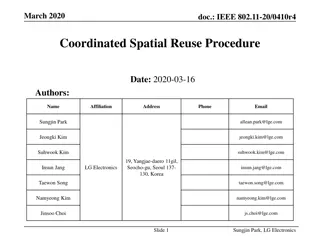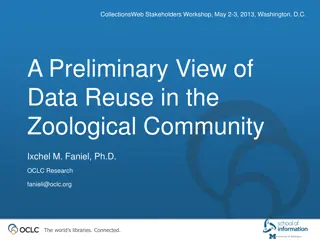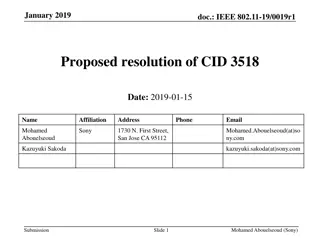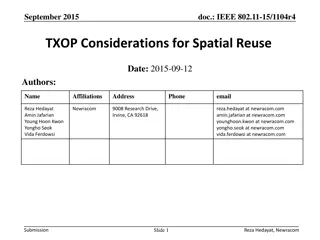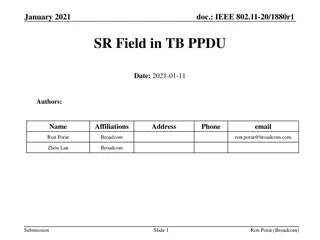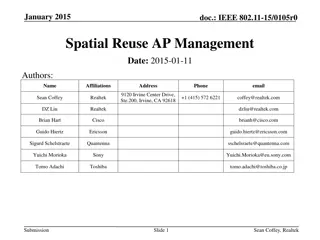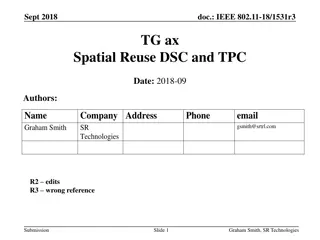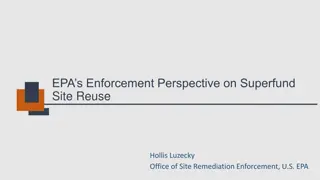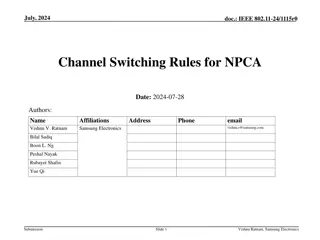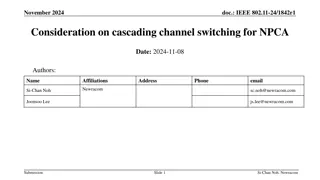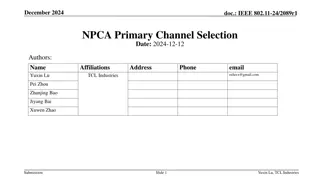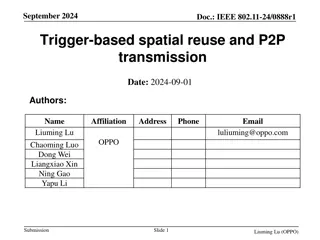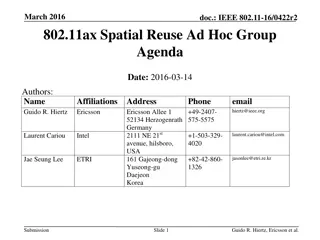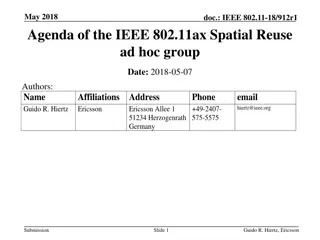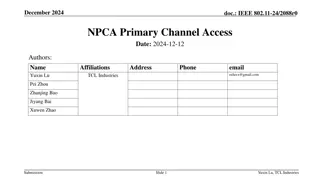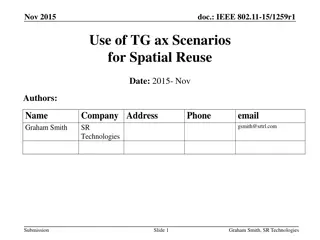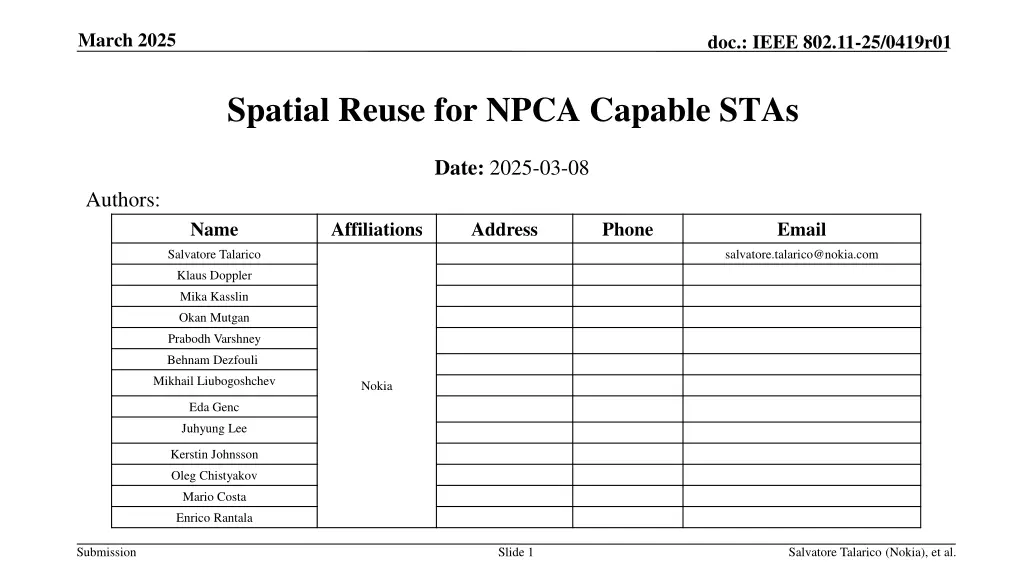
IEEE 802.11-25 Spatial Reuse for NPCA Capable STAs
Explore the integration of Spatial Reuse with NPCA capabilities in IEEE 802.11, addressing challenges and solutions for efficient wireless communication. Learn about BSS coloring, OBSS Packet Detection, and Parametrized SR to enhance network performance and reduce interference.
Download Presentation

Please find below an Image/Link to download the presentation.
The content on the website is provided AS IS for your information and personal use only. It may not be sold, licensed, or shared on other websites without obtaining consent from the author. If you encounter any issues during the download, it is possible that the publisher has removed the file from their server.
You are allowed to download the files provided on this website for personal or commercial use, subject to the condition that they are used lawfully. All files are the property of their respective owners.
The content on the website is provided AS IS for your information and personal use only. It may not be sold, licensed, or shared on other websites without obtaining consent from the author.
E N D
Presentation Transcript
March 2025 doc.: IEEE 802.11-25/0419r01 Spatial Reuse for NPCA Capable STAs Date: 2025-03-08 Authors: Name Affiliations Address Phone Email Salvatore Talarico salvatore.talarico@nokia.com Klaus Doppler Mika Kasslin Okan Mutgan Prabodh Varshney Behnam Dezfouli Mikhail Liubogoshchev Nokia Eda Genc Juhyung Lee Kerstin Johnsson Oleg Chistyakov Mario Costa Enrico Rantala Submission Slide 1 Salvatore Talarico (Nokia), et al.
March 2025 doc.: IEEE 802.11-25/0419r01 Introduction During the past IEEE 802.11 Interim and Ad-Hoc meetings, NPCA has been agreed ([1-10]) and the following motion was approved: This motion does not indicate any restrictions about the received power of the OBSS: the received power must be higher than -82 dBm for PD. However, this value may change if Spatial Reuse (SR) is used. During the Warsaw IEEE 802.11 Interim Meeting, it was agreed to disable the parametrized SR (PSR), when NPCA is enabled [11], and to further discuss the interoperability between OBSS-PD SR and NPCA. Submission Slide 2 Salvatore Talarico (Nokia), et al.
March 2025 doc.: IEEE 802.11-25/0419r01 Recap: 802.11ax Spatial Reuse In 802.11ax, The concept of BSS coloring was introduced which assigns a unique label to each BSS AP randomly selects a color (1-63) and mentions it in the HE Operation element in the beacon or probe responses, which is indicated in the SIG-A field of the PHY header for any frames sent in the BSS. If collision is detected (STAs belonging to an OBSS are using same color), a collision is reported through an Event Report Frame where an AP disables its own color (BSS Color Disabled bit in the HE Operation element) and then sends a BSS Color Change Announcement or a specific HE BSS Color Change announcement action frame. Some interference mitigation techniques are introduced with two flavors: OBSS Packet Detection (PD)-based SR: used mainly for untriggered transmissions and to allow to ignore the transmissions of the OBSS system thereby by choosing properly an OBSS PD thresholds, and consequently reducing the transmit power to minimize the disruptions to the neighboring OBSS when transmitting concurrently Parametrized SR (PSR): used for trigger-based transmissions and aims to inform STAs in the neighboring OBSSs how much they can transmit without affecting the reference AP s ability to properly decode the uplink frames from its own associated STAs Submission Slide 3 Salvatore Talarico (Nokia), et al.
March 2025 doc.: IEEE 802.11-25/0419r01 Problem Statement When NPCA is jointly enabled with SR, based on the OBSS PD thresholds that STAs may select the ambiguity that NPCA creates when it comes to determining when to switch to the NPCA primary channel is exacerbated. In the example below, SR with non-SRG OBSS PD is jointly enabled with NPCA, and within BSS1 all the STAs will accordingly select their OBSS PD values so that to reduce footprint and impact on BSS2. However, while AP1 and STA1 select their non-SRG OBSS PD so that they can ignore transmissions from AP2, STA1* cannot. So this would lead AP1 and STA1 to continue to stay on the primary channel, while STA1* will switch to NPCA primary channel. Submission Slide 4 Salvatore Talarico (Nokia), et al.
March 2025 doc.: IEEE 802.11-25/0419r01 Evaluations Simulation Parameters Deployment Assumptions TxOP-Based NPCA with TxOP length of 1.5 ms BSS and OBSS operate on the same primary channel Same Tx power and noise figure across all STAs BSS BW of 160 MHz Primary 80 MHz when primary is used Secondary 80 MHz when NPCA primary is used No link adaptation (for simplicity) Tx is done with typical MCS 7 (64-QAM and 5/6 coding rate) MCS 5 is used when Tx power is reduced due to SR STAs having full buffer Omnidirectional antennas at both AP and non-AP STA All STAs have same switching delay: [128us] 1 Reference AP and 1 OBSS AP with R=1 4 associated non-AP STAs per each AP Ref AP OBSSAP D OBSS non-AP STA Ref non-AP STA R Submission Slide 5 Salvatore Talarico (Nokia), et al.
March 2025 doc.: IEEE 802.11-25/0419r01 Evaluations Results Observations: NPCA allows to achieve higher aggregated throughput when the OBSS is closer, while OBSS-PD based SR is preferred when the distance among BSS and OBSS is larger. When NPCA and OBSS-PD based SR are jointly used, more STAs will end up having different perspective on whether an OBSS transmission shall or shall not trigger a switch to the NPCA primary channel, which leads to high degradation in terms of aggregated throughput especially as the distance between BSS and OBSS is smaller. In order to have a more homogeneous behavior across all STAs, when operating NPCA and SR jointly, SR could be enhanced by introducing a common PD threshold that is announced by the AP and used by all the non-AP STAs (eSR). This allows to mitigate the ambiguity across STAs in terms of which primary channel to use Allows STAs to avoid more frequently to switch to the NPCA primary channel, which leads to spectral efficiency loss due to the related switching delays. Submission Slide 6 Salvatore Talarico (Nokia), et al.
March 2025 doc.: IEEE 802.11-25/0419r01 Proposal In order to mitigate the issue highlighted in this deck of slide: Option 1: NPCA is never used jointly with OBSS-PD based SR Since these two features address the same issue (i.e., overlapping of OBSS transmissions), these are used orthogonally based on TBD conditions Option 2 (Preferred): NPCA can be jointly used with OBSS PD-based SR A common OBSS PD threshold is defined to mitigate the ambiguity in switching among devices belonging to the same BSS NPCA primary channel is triggered by the detection of OBSS Control frame exchange (e.g., (MU-)RTS/CTS) or OBSS HE/EHT/UHR PPDU with a power level higher than the common OBSS PD threshold SR transmit power constraints are applied regardless of whether a STA operate on primary or NPCA primary channel Submission Slide 7 Salvatore Talarico (Nokia), et al.
March 2025 doc.: IEEE 802.11-25/0419r01 Summary In this contributions, we discussed the negative impact of SR on NPCA, when these two features are used together. To address this issue two options are provided: Option 1: NPCA is never used jointly with OBSS-PD based SR Option 2 (Preferred): NPCA can be jointly used with OBSS PD-based SR A common OBSS PD threshold is defined to mitigate the ambiguity in switching among devices belonging to the same BSS NPCA primary channel is triggered by the detection of OBSS Control frame exchange (e.g., (MU-)RTS/CTS) or OBSS HE/EHT/UHR PPDU with a power level higher than the common OBSS PD threshold SR transmit power constraints are applied regardless of whether a STA operate on primary or NPCA primary channel Submission Slide 8 Salvatore Talarico (Nokia), et al.
March 2025 doc.: IEEE 802.11-25/0419r01 Straw Poll #1 Do you agree that when NPCA and OBSS PD based SR are operated jointly, an AP indicates in the SR Parameter Set element a common PD threshold that all its associated STAs shall use? Yes No Abstain Submission Slide 9 Salvatore Talarico (Nokia), et al.
January 2025 doc.: IEEE 802.11-25/0419r01 References [1] IEEE 802.11-23/34, Non-primary channel utilization , Sindhu Verma [2] IEEE 802.11-23/631, Secondary channel usage and secondary 20MHz channel backoff , Liwen Chu [3] IEEE 802.11-23/797, Non-primary channel access , Yongho Seok [4] IEEE 802.11-23/961, UHR secondary channel access , Minyoung Park [5] IEEE 802.11-23/1112, Thoughts on secondary channel access , Insun Jang [6] IEEE 802.11-23/1365, Discussions on non-primary channel access , Sanghyun Kim [7] IEEE 802.11-23/1891, Nonprimary Channel Access Follow-Up , Gaurang Naik [8] IEEE 802.11-23/1911, Secondary channel access and frame transmission , Dongju Cha [9] IEEE 802.11-23/1951, Concurrent CCA for non-primary channel access , Leonardo Lanante [10] IEEE 802.11-24/1762, PDT-MAC-NPCA , Matthew Fischer [11] IEEE 802.11-24/0757, CC50 CR for CID 2697 - Spatial Reuse for NPCA Capable STAs , Salvatore Talarico Submission Slide 10 Salvatore Talarico (Nokia), et al.
January 2025 doc.: IEEE 802.11-25/0419r01 Appendix Submission Slide 11 Salvatore Talarico (Nokia), et al.

